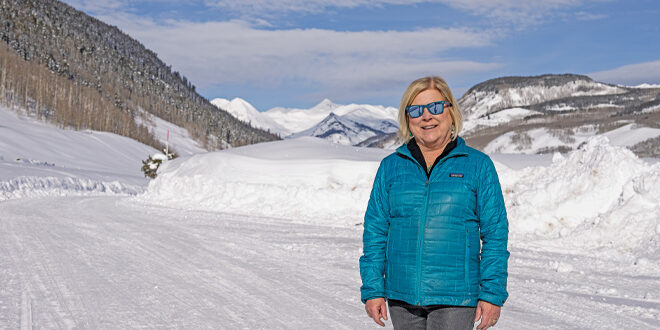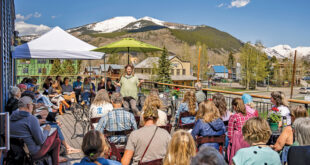By Dawne Belloise
Like her mom, Diane Clark was artistically inclined so in her youth she took a lot of art classes at a gallery in Buffalo, New York, close to the suburb of Hamburg where she grew up. The young artist fell in love with science, particularly chemistry, when a teacher in school allowed her to do experiments prior to their being done in the chemistry lab. “Sometimes the experiments would go well and sometimes…” she nods and recalls, “One time the equipment caught on fire. We didn’t do that experiment again.”
Diane’s mom was an artist who wanted to be a painter but needed to make a living so she studied fashion design. “I never had a store bought set of clothes until I was in high school,” Diane says, and explains that her creative mother made all her clothing. Diane’s father was a mechanical engineer in the steel industry. She and her brother roamed around with the other kids in the neighborhood near their school which afforded them the use of a playground, a sledding hill and ice skating rink. “Women’s sports weren’t huge when I was growing up,” Diane tells but she did play intramural tennis.
After high school graduation in 1972, Diane’s love of chemistry led her to Allegheny College in Pennsylvania, which wasn’t too far from home. “I had friends going there and the school’s science and chemistry departments were top notch,” she says. But once there, she found that she didn’t really like Allegheny and in her sophomore year applied as a summer exchange student to Dartmouth College because they had programs she wanted. She pushed through her junior year at Allegheny, to finish a year early in 1975 and enrolled at Dartmouth’s program to earn a Bachelor of Engineering. She decided to stay at Dartmouth, earning her Masters in Biochemical Engineering in 1978 and her Doctorate, also in Biochemical Engineering in 1981. Diane was the first woman to earn a Doctorate of Engineering from Dartmouth.
With her focus in renewable biofuels, Diane was planning on getting a job in the industry and was hired by Exxon in their synthetic fuels process division. She liked it, but then, she smiles, “I got married and had a baby about the same time Exxon got rid of my division,” so serendipitously, she was paid to leave. She had met Rick Clark when attending graduate classes at Dartmouth. “Because the engineering parties were boring, my girlfriend and I crashed the business school party.” She and Rick started dating, married in 1982, and their daughter Heather was born that year as well. Her second daughter, Laurel (now married as Runcie), came along in 1984, and son Richie was born in 1988. “They were all born in different places because we moved a lot for Rick’s work,” she explains.
Diane was working in New Jersey and Rick was working in the Philadelphia area, then Rick was hired as chief operations officer for an ethanol company in Maryland and they moved to the eastern shore in 1983. “And I hated it. It was very southern plantation oriented, and back then there was nothing to do.” So Rick quit his job and they moved to Cazenovia, New York, to help expand Rick’s family business of gasoline distribution with a chain of central New York convenience stores. Diane took a position with an environmental consulting company. She started out in wastewater projects and ended up as the lead engineer for hazardous waste cleanups that involved “everything that came in involving coal tar, solvents and PCBs. I was very happy there.”
Rick bought out his uncle’s share of the family business and when his father retired, Rick ended up with the company, merging it with two friendly competitors to start a new convenience store chain called Fast Trak. Diane was then able to retire early, besides, she notes, “Women in engineering firms don’t get responsibilities even if they’re ranked higher in position. I was writing proposals that would get the firm projects and I couldn’t be project manager because they wanted men to be the project managers,” she says and the frustration of being ranked higher, and with more knowledge than the men who were getting the promotions was more than she could continue to tolerate. “I was developing the client relationships but wasn’t allowed to continue that through the project life.” The firm actually wanted her to teach the men what the laws were, so they’d do the project correctly. “Basically, I came home and said, ‘Rick, I can’t do this anymore.’ His company had grown enough that we were getting a good income, so I stayed home.” By that time, only her son was at home; the girls were in college.
When word got out that Diane was no longer working, her phone started ringing with volunteer opportunities. The first one she accepted was for the board of trustees for a New York state historic site, the Lorenzo Mansion. “I had an interest in historic properties and we owned a very historic home in Cazenovia built in 1810, which was at one time the home of Susan Blow who started the whole concept of kindergarten education.” She remained on that board for seven years. She also joined the Cazenovia Forum, which is similar to the Public Policy Forum in Crested Butte. “We brought speakers from all over the world,” she says. She was on the forum board for over 10 years. Although they still own a house in Cazenovia, they only return for a few months a year. Now entrenched in Crested Butte, she says, “We’ve been fixing it up to sell.”
When her daughter Laurel and her boyfriend moved to Crested Butte in 2008 to do a ski bum year, Diane and Rick ventured out for visits. Diane says they were already an avid ski family, often skiing Banff, Jasper, Jackson Hole, Steamboat, Vail, Mad River Glen in Vermont and Whiteface in the Adirondacks. “But we had never skied CB, although I knew about it. John and Robin Norton were at Dartmouth at the same time we were, but we didn’t know each other.” However, the Dartmouth alumni would hear about CB skiing and when their daughter moved here permanently, they’d come out to ski. “The first time we came out other than skiing was for Laurel’s wedding on Labor Day weekend in 2010. It was just beautiful. We started coming out more often.” Their son Richie followed, moving to CB in 2015. “We got a condo and started to think about retirement. We felt this would be a great place to retire. We like the snow. We started looking for a house here in 2018 and Rick sold the business in 2019.”
They bought a home up Peanut Lake Road in November of 2019. A few months later, when COVID hit in March of 2020, Diane recalls, “We essentially got kicked out when the county prohibited second homeowners from staying. They applied to stay in their house, since they were already in the process of moving, but it took two weeks to get the permission and by then they had decided to go back to New York where they had doctors and medical facilities in case they got sick. Rick and Diane were able to return to CB the end of June in 2021. Their son was married in their backyard and their oldest daughter, Heather, also moved to CB from Chicago, “So the whole family is here now,” she smiles.
When they’re not working or taking care of the kids, they ski on the mountain and do a lot of cross-country skiing, “Especially given our location.” They have two Buttian-born grandsons now. Diane is the treasurer for All Saints in Mountains Episcopal Church. “Because of the outreach through the Episcopal Church, I’ve become more active supporting the food bank and Project Hope, the group that helps people who are in abusive relationships and removes them from it. With the food pantry, our church’s mission, along with the Good Samaritan Church of Gunnison, has a strong commitment to outreach and they have a mobile van filled up with food. On Saturdays we drive it to the southern part of the county to distribute food to people who are food insecure,” she says of the free service. She’s volunteered to help with artists and booths at the People’s Fair as well, and says, “I love Crested Butte. I have a love of the mountains here, and family keeps me here. It’s my happy place.”
 The Crested Butte News Serving the Gunnison Valley since 1999
The Crested Butte News Serving the Gunnison Valley since 1999




